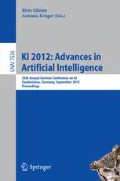Abstract
We interpret biological motion trajectories as being composed of sequences of sub-blocks or motion primitives. Such primitives, together with the information, when they occur during an observed trajectory, provide a compact representation of movement in terms of events that is invariant to temporal shifts. Based on this representation, we present a model for the generation of motion trajectories that consists of two layers. In the lower layer, a trajectory is generated by activating a number of motion primitives from a learned dictionary, according to a given set of activation times and amplitudes. In the upper layer, the process generating the activation times is modeled by a group of Integrate-and-Fire neurons that emits spikes, dependent on a given class of trajectories, that activate the motion primitives in the lower layer. We learn the motion primitives together with their activation times and amplitudes in an unsupervised manner from unpartitioned data, with a variant of shift-NMF that is extended to support the event-like encoding. We present our model on the generation of handwritten character trajectories and show that we can generate good reconstructions of characters with shared primitives for all characters modeled.
Access this chapter
Tax calculation will be finalised at checkout
Purchases are for personal use only
Preview
Unable to display preview. Download preview PDF.
References
Bizzi, E.: Modular organization of motor behavior in the frog’s spinal cord. Trends in Neurosciences 18(10), 442–446 (1995)
Cichocki, A., Zdunek, R., Phan, A., Amari, S.: Nonnegative Matrix and Tensor Factorizations. Wiley (2009)
Ding, C., Li, T., Jordan, M.I.: Convex and semi-nonnegative matrix factorization for clustering and low-dimension representation (2006)
Eggert, J., Wersing, H., Körner, E.: Transformation-invariant representation and NMF. In: Proceedings of the 2004 IEEE International Joint Conference on Neural Networks, vol. 4, pp. 2535–2539. IEEE (2004)
Kim, T., Shakhnarovich, G., Urtasun, R.: Sparse Coding for Learning Interpretable Spatio-Temporal Primitives. In: Advances in Neural Information Processing Systems 22 (December 2010)
Kulic, D., Ott, C., Lee, D., Ishikawa, J., Nakamura, Y.: Incremental learning of full body motion primitives and their sequencing through human motion observation. International Journal of Robotics Research 31(2), 330–345 (2011)
Lee, D., Seung, H.: Learning the parts of objects by non-negative matrix factorization. Nature 401(6755), 788–791 (1999)
Lewicki, M.S., Sejnowski, T.J.: Coding time-varying signals using sparse, shift-invariant representations. In: Advances in Neural Information Processing Systems 11 (1999)
Meier, F., Theodorou, E., Stulp, F., Schaal, S.: Movement segmentation using a primitive library. In: 2011 IEEE/RSJ International Conference on Intelligent Robots and Systems (IROS), pp. 3407–3412. IEEE (2011)
Roux, J.L., de Cheveign, A., Parra, L.C.: Adaptive Template Matching with Shift-Invariant Semi-NMF. In: Advances in Neural Information Processing Systems 21 (2009)
Smith, E., Lewicki, M.S.: Efficient coding of time-relative structure using spikes. Neural Computation 17(1), 19–45 (2005)
Williams, B., Toussaint, M., Storkey, A.: A primitive based generative model to infer timing information in unpartitioned handwriting data. In: Proceedings of the 20th International Joint Conference on Artifical Intelligence, IJCAI 2007 (2007)
Author information
Authors and Affiliations
Editor information
Editors and Affiliations
Rights and permissions
Copyright information
© 2012 Springer-Verlag Berlin Heidelberg
About this paper
Cite this paper
Vollmer, C., Eggert, J.P., Gross, HM. (2012). Modeling Human Motion Trajectories by Sparse Activation of Motion Primitives Learned from Unpartitioned Data. In: Glimm, B., Krüger, A. (eds) KI 2012: Advances in Artificial Intelligence. KI 2012. Lecture Notes in Computer Science(), vol 7526. Springer, Berlin, Heidelberg. https://doi.org/10.1007/978-3-642-33347-7_15
Download citation
DOI: https://doi.org/10.1007/978-3-642-33347-7_15
Publisher Name: Springer, Berlin, Heidelberg
Print ISBN: 978-3-642-33346-0
Online ISBN: 978-3-642-33347-7
eBook Packages: Computer ScienceComputer Science (R0)

